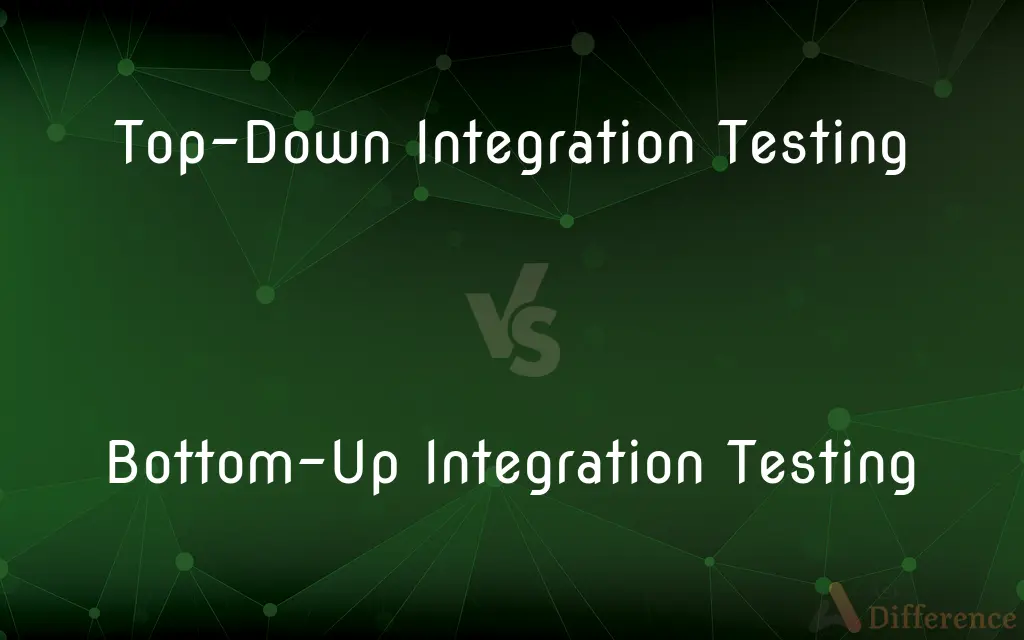Top-Down Integration Testing vs. Bottom-Up Integration Testing — What's the Difference?
By Tayyaba Rehman & Urooj Arif — Published on February 3, 2024
Top-Down Integration Testing begins with high-level modules and integrates downwards, using stubs for lower levels. Bottom-Up Integration Testing starts with low-level modules, using drivers for upper levels.

Difference Between Top-Down Integration Testing and Bottom-Up Integration Testing
Table of Contents
ADVERTISEMENT
Key Differences
Top-Down Integration Testing in software development starts at the top of the system hierarchy, testing the main control module first. This approach then progressively integrates and tests lower-level modules using temporary programs called stubs. In contrast, Bottom-Up Integration Testing begins with the lowest-level modules. It gradually works its way up to the top of the system hierarchy, employing drivers - temporary programs that simulate higher-level modules.
In Top-Down Integration Testing, the focus is on the functionality of major control parts of the system early in the test cycle. It allows developers to detect significant flaws in key areas first. Conversely, Bottom-Up Integration Testing enables developers to test the most basic operations at the start, ensuring that the foundational components of the system work correctly before integrating higher-level modules.
Top-Down Integration Testing facilitates early prototype demonstration since the top-level functionalities are tested first. It's beneficial for projects requiring early validation of major functions. On the other hand, Bottom-Up Integration Testing is more suited for scenarios where lower-level modules need thorough validation before integrating into the larger system, ensuring robust base functionality.
The Top-Down approach can be more challenging when dealing with user interfaces or high-level abstract modules, as stubs may not adequately simulate lower-level modules. Bottom-Up Integration Testing, however, can delay the testing of user interfaces and overall system functionality until later in the process, as the focus is initially on the lower levels.
Top-Down Integration Testing is often preferred when major flaws are expected at the higher levels of the system. It allows for early detection and correction. Bottom-Up Integration Testing, however, is more efficient when the system's foundation is expected to have more issues, allowing for a solid building-up of functionality.
ADVERTISEMENT
Comparison Chart
Starting Point
Begins with high-level modules
Starts with low-level modules
Auxiliary Components Used
Uses stubs for untested lower-level modules
Uses drivers for untested higher-level modules
Focus in Early Stages
Tests major control functions first
Tests basic operations and foundational components first
Suitability
Preferred for early demonstration and validation of main functions
Ideal for ensuring robustness of basic operations before integration
Challenges and Limitations
Stubs may not adequately represent lower-level functionality
Delays testing of user interfaces and overall system integration
Compare with Definitions
Top-Down Integration Testing
Testing approach starting from high-level modules down to lower levels.
In our project, we used Top-Down Integration Testing to first ensure the main control system was fully functional.
Bottom-Up Integration Testing
Integration testing where foundational operations are tested first.
We started with Bottom-Up Integration Testing to solidify the basic functionalities of our software.
Top-Down Integration Testing
Approach enabling early prototype testing of a system’s major functions.
Top-Down Integration Testing was crucial for demonstrating the early prototype to stakeholders.
Bottom-Up Integration Testing
Testing strategy beginning with the lowest-level modules, moving upwards.
Bottom-Up Integration Testing ensured our system's foundational components were reliable before adding more complexity.
Top-Down Integration Testing
A method using stubs to test higher-level modules before lower ones.
Stubs were employed in the Top-Down Integration Testing to simulate the lower-level modules initially.
Bottom-Up Integration Testing
Method suitable for ensuring robustness of basic system operations.
We chose Bottom-Up Integration Testing to build a strong base for the system before integrating complex modules.
Top-Down Integration Testing
Focuses on main control parts of a system in early testing stages.
We adopted Top-Down Integration Testing to quickly assess the core functionalities of our application.
Bottom-Up Integration Testing
Focuses on basic operations and components in the initial testing stages.
The Bottom-Up Integration Testing approach helped us identify foundational bugs early in the development process.
Top-Down Integration Testing
Integration testing where top-level system functionality is tested first.
Top-Down Integration Testing allowed us to identify issues in the primary interface early on.
Bottom-Up Integration Testing
Utilizes drivers to test lower modules before integrating higher ones.
Drivers simulated higher-level modules during our Bottom-Up Integration Testing phase.
Common Curiosities
What is the main goal of Top-Down Integration Testing?
The primary goal is to identify and address integration issues between higher-level components early in the development process.
What are the advantages of Top-Down Integration Testing?
It helps in uncovering high-level design flaws, promoting early error detection, and providing a more comprehensive view of system functionality.
What is a stub in Top-Down Integration Testing?
A stub is a temporary module or function used to simulate lower-level modules that are not yet developed or available.
What is Top-Down Integration Testing?
Top-Down Integration Testing is a software testing approach where higher-level modules are tested before lower-level modules.
What is the major disadvantage of Top-Down Integration Testing?
The major drawback is that real lower-level modules are tested much later in the development cycle, potentially delaying the detection of issues.
Is Top-Down Integration Testing suitable for agile development methodologies?
Yes, it can be adapted for agile development, but it may require frequent adjustments as the code evolves.
What is a driver in Bottom-Up Integration Testing?
A driver is a temporary module or function used to simulate higher-level modules that are not yet developed or available.
How does Top-Down Integration Testing help in test prioritization?
It allows testers to focus on critical components and functionalities first, improving risk management.
What is Bottom-Up Integration Testing?
Bottom-Up Integration Testing is a software testing approach where lower-level modules are tested before higher-level modules.
What is a major consideration when using Bottom-Up Integration Testing with third-party components?
Ensuring that third-party components are reliable and correctly integrated is crucial since they are typically treated as lower-level modules.
Can Bottom-Up Integration Testing be used in conjunction with other testing methods?
Yes, it can be combined with other testing methods, such as Top-Down or Big Bang Integration Testing, to achieve comprehensive coverage.
Which integration testing approach, Top-Down or Bottom-Up, is better?
The choice depends on the project's specific needs and constraints. Both approaches have their advantages and drawbacks, and the selection should align with the project's goals and development methodology.
What is the primary advantage of Bottom-Up Integration Testing?
It enables the testing of core functionalities and foundational components early in the development cycle.
What are some potential drawbacks of Bottom-Up Integration Testing?
It may delay the identification of high-level design flaws and might not provide a complete system view until late in testing.
How does Bottom-Up Integration Testing align with incremental development approaches?
It aligns well with incremental development as it allows for the gradual integration and testing of lower-level components.
Share Your Discovery

Previous Comparison
Sheesham Wood vs. Mango Wood
Next Comparison
Bismuth Subsalicylate vs. Bismuth SubcitrateAuthor Spotlight
Written by
Tayyaba RehmanTayyaba Rehman is a distinguished writer, currently serving as a primary contributor to askdifference.com. As a researcher in semantics and etymology, Tayyaba's passion for the complexity of languages and their distinctions has found a perfect home on the platform. Tayyaba delves into the intricacies of language, distinguishing between commonly confused words and phrases, thereby providing clarity for readers worldwide.
Co-written by
Urooj ArifUrooj is a skilled content writer at Ask Difference, known for her exceptional ability to simplify complex topics into engaging and informative content. With a passion for research and a flair for clear, concise writing, she consistently delivers articles that resonate with our diverse audience.
















































